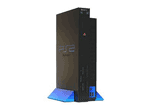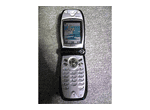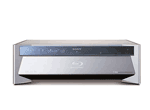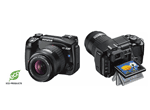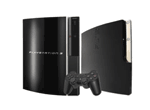Application Products
2000s
2000: PlayStation 2 (PS2) handles DVD playback (Sony)
On March 4th in 2000, SCEI released the PS2 with its rumored DVD-playback functionality and backward compatibility with PlayStation games. This successor to the PlayStation marked record sales of 980 thousand units in the three days following its release. By November 2005, 100 million units had been sold worldwide.
The Graphics Synthesizer incorporated a 4-Mbyte DRAM, and was in fact one of the first LSIs to contain a large DRAM. The PS2 also included the 128-bit Emotion Engine CPU running at 294.912 MHz (0.25-mm process) and 32-Mbyte main memory (direct RDRAM).
November 18th, 2001: Launch of the Suica contactless IC card
On November 18th in 2001, JR East launched Japan’s first contactless IC fare card, Suica. This was initially usable at 424 stations in the Kanto region. Suica is based on contactless IC-card technology called FeliCa that was developed by Sony.
2001: W-CDMA mobile phones (NTT DoCoMo)
Wideband Code-Division Multiple Access (W-CDMA) is an air interface standard developed by NTT DoCoMo in collaboration with European mobile-phone companies such as Nokia and Ericsson.
W-CDMA has been deployed in European and Asian countries. In Japan, NTT DoCoMo’s FOMA, Softbank Mobile’s SoftBank 3G, and EMOBILE phones are all based on W-CDMA. The direct conversion technique (or homodyne technique) adopted in these mobile phones allows quadrature modulation and quadrature detection between the baseband and radio-frequency band.
Since the approach requires no interface filters and only one synthesizer each for transmission and reception, it eased the miniatualization and integration of circuits. Although introduction of the direct conversion technique was made possible by advances in analog semiconductor-process technologies such as SiGe-BiCMOS, adoption of the W-CDMA standard itself simplified the development of a direct receiver.
2001: The iPod digital audio player (Apple)
The first model of the iPod was released on October 24th, 2001 as a digital audio player which was exclusively compatible with the Apple Macintosh. The concept behind the iPod is bringing music out of the “iTunes library” where it is stored. This approach clearly differs from that of earlier digital music players in that Apple requires that the owner install iTunes on the host machine first. While two ARM 7TDMI CPUs (running at 90 MHz) were used in iPods of the first to third generations, later models employed variable-speed chips (running at up to 80 MHz) that dynamically change the frequency according to CPU usage in order to keep the iPod operating for longer hours from a given battery.
The CPU of the recent fifth generation of iPods is the PP5021, which is specifically made by PortalPlayer for digital audio players.
2003: World’s first Blu-ray Disc recorder (Sony)
Sony released the BDZ-S77 Blu-ray Disc recorder on April 10th, 2003. This recorder was restricted to single-sided single-layer discs (23.3 Gbytes). The use of a 405-nm blue violet semiconductor laser and an optical disc with a 0.1-mm protective layer raised the numerical aperture (NA) value of the lens from 0.65 to 0.85 and realized large capacities (25 Gbytes on a single-layer disc and 50 Gbytes on a double layer disc) over five times those of the corresponding DVD formats.
2004: Digital single-lens reflex (SLR) camera (Olympus)
Olympus’ E-330 was the first digital SLR camera to support the “full-time live view” feature. For the development of digital SLR cameras, manufacturers started to combine their traditional know-how regarding SLR cameras with digital technologies such as image sensors and image processing.
This trend initiated fierce competition in the market, leading to events such as the acquisition of long-established camera companies by major electronics companies and success for camera companies that have specific image-sensor technologies. For the E-330, Olympus adopted a 7.5-megapixel Live MOS sensor made by Panasonic as the image sensor and a 1/2.5-type 5-megapixel CCD (for compact digital cameras) for the optical viewfinder.
2006: PlayStation 3 handles high-definition graphics (Sony)
The PlayStation 3 was released as the successor to the PlayStation 2 in November 2006 in Japan and the U.S.A., and in March 2007 in Europe and Australia. This was about a year after the release of its rival, the Xbox 360.
The PlayStation 3’s newly supported features follow worldwide trends towards high-definition TV broadcasting, and include Blu-ray Discs (developed by several companies, including Sony and Panasonic) as the standard optical disc, a High-Definition Multimedia Interface (HDMI) for the transfer of high-quality image data, and high resolutions (up to 1920 ´ 1080).
The “brains” of the PlayStation 3, a Toshiba-made Cell Broadband Engine™, is capable of handling multiple processes at the same time and thus enables remarkably fast and high-level processing.
Late 2000s: Competition in the development of electric cars
The Eliica, developed by the Electric Vehicle Laboratory at Keio University in Tokyo, has achieved a maximum speed of 370 km/h and acceleration from 0–100 km/h in 4.1 seconds, proving that the simpler power train can lead to higher performance in driving than a car with an internal combustion engine. Along with improvements in the performance of batteries, advances in power electronics such as the use of inverters (which improve the efficiency of power usage) to control variable voltages and frequencies were the main contributors to the significant improvements in the performance of electric cars (and the emergence of mass-produced hybrid cars) since the 1990s.
Since electric cars can now achieve higher performance than in earlier days, makers in the automobile industry are moving to re-evaluate electric cars. Several companies, including Fuji Heavy Industries Ltd. and Mitsubishi Motors Corporation, have already announced plans to develop electric cars.
Toyota has been trying to greatly expand the capacity of batteries in hybrid cars and has also been developing the “Plug-in Hybrid” technology, which allows the recharging of batteries with external power.


